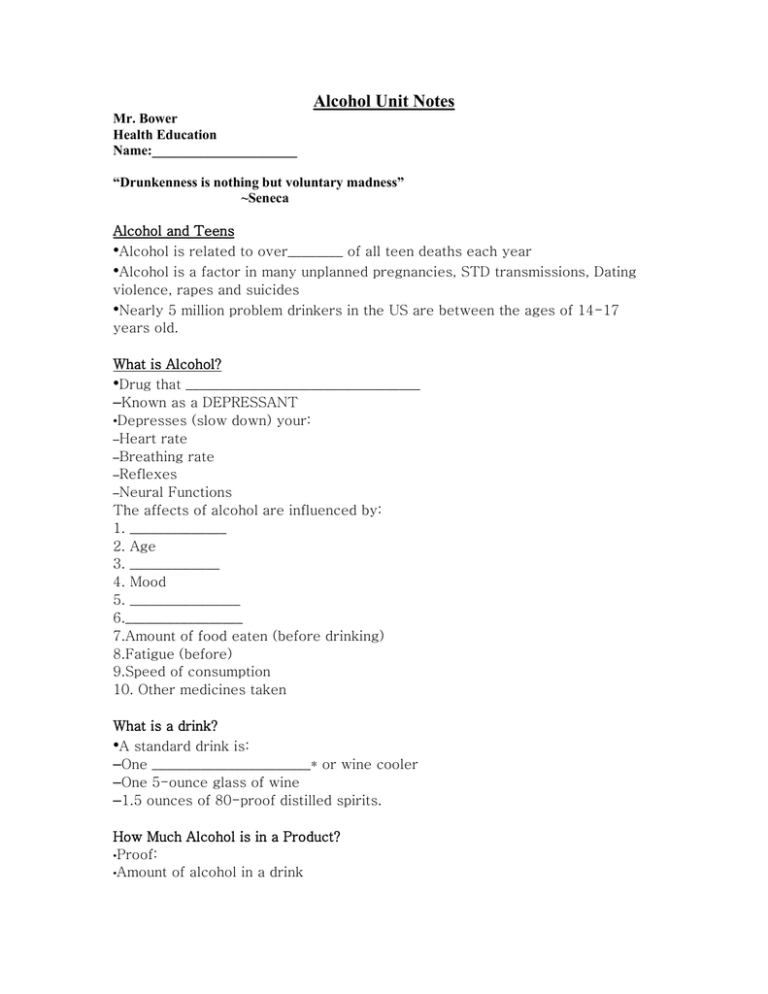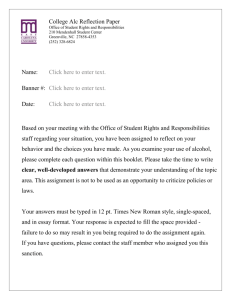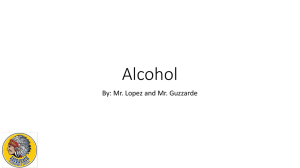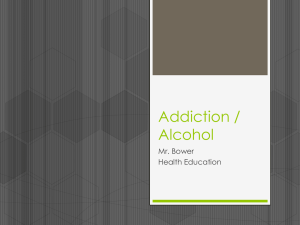Alcohol Unit Notes
advertisement

Alcohol Unit Notes Mr. Bower Health Education Name:_____________________ “Drunkenness is nothing but voluntary madness” ~Seneca Alcohol and Teens •Alcohol is related to over________ of all teen deaths each year •Alcohol is a factor in many unplanned pregnancies, STD transmissions, Dating violence, rapes and suicides •Nearly 5 million problem drinkers in the US are between the ages of 14-17 years old. What is Alcohol? •Drug that __________________________________ –Known as a DEPRESSANT •Depresses (slow down) your: –Heart rate –Breathing rate –Reflexes –Neural Functions The affects of alcohol are influenced by: 1. ______________ 2. Age 3. _____________ 4. Mood 5. ________________ 6._________________ 7.Amount of food eaten (before drinking) 8.Fatigue (before) 9.Speed of consumption 10. Other medicines taken What is a drink? •A standard drink is: –One _______________________* or wine cooler –One 5-ounce glass of wine –1.5 ounces of 80-proof distilled spirits. How Much Alcohol is in a Product? •Proof: •Amount of alcohol in a drink •Double the _______________ of alcohol. 20% Alcohol = 40 proof •Drinks and Averages •Beer: 4% Alcohol •Wines: 12-14% Alcohol •Wine cooler: 1.5-6% Alcohol •Liquors: 40% Alcohol Effects on Body Good/Healthy Liver •Ex. Long-term Effects of Alcohol on the Body To the Brain – •Addiction – inability to stop drinking •Loss of verbal skills, ________________ •Major brain damage Cardiovascular Changes •Damage to the heart muscle •Enlarged heart – from increased workload caused by alcohol •High blood pressure – can cause heart attack/stroke Long term effects ____________ – •fatty liver – fats builds up and cannot be broken down – excess fat blocks the flow of blood to liver cells, leading to cell death •Alcoholic hepatitis – inflammation of the liver caused by the toxic effects of alcohol •____________ – liver tissue is replaced with _______________. This disease can lead to liver failure and death. Alcohol’s effect on the body Digestive system •Irritation – digestive lining is damaged; can lead to stomach ulcers and cancer of the stomach and esophagus Pancreas Problems •Chemicals begin to destroy the pancreas, causing pain, vomiting, and can lead to death Other Problems With Drinking Alcohol •Alcohol is a toxin. –Toxin: a substance that is poisonous (To all parts of body) •_______________________ (FAS) –The presence of severe birth defects in babies born to mother who drink alcohol during pregnancy. •Babies with FAS may have small eye slits, small head, and retarded physical and mental growth. •Leading cause of ____________________. •Blackouts –A period in which a person cannot remember what has happened. Alcohol and your BAC •Alcohol is absorbed into the bloodstream in the small intestines. Blood Alcohol Content and DUI –The amount of alcohol content found in your blood –The higher BAC, the more impairment occurs •Legal Limit for Adult: .08 BAC •Underage Intoxication Limit: .02 BAC •Anything beyond is considered Driving Under the Influence (DUI) Impairments •BAC of .02= decision making impaired. •BAC of .05= reasoning and judgment are impaired, decreased muscular coordination and reaction time. •BAC of .10= reasoning, judgment, self control, muscular coordination, and reaction time are seriously impaired. •BAC of .12= confused, disoriented, blurred vision, vomit. •BAC of .20= emotions are unpredictable, may pass out. •BAC of .30= little or no control over mind and body. •BAC of .40= unconscious and possible death Questions for Discussion •Just because it is legal, does having a BAC below .08 make you safe? •Should a driver be able to have a blood alcohol content? •Should teens have a .02 BAC for DUI? The disease of Alcoholism Alcoholism •Is a disease in which a person has a physical and/or a psychological dependence on alcohol. •Will show itself in different behaviors - violent, aggressive, withdrawn, quiet •Is a craving – he/she cannot manage stress without the use •Is a loss of control – he/she cannot limit his drinking and is preoccupied with alcohol •Is a Physical dependence – without alcohol, will experience withdrawal symptoms The disease of Alcoholism •An alcoholic will build a Tolerance to alcohol - a need to drink increasingly greater amounts in order to feel its effects •An alcoholic will experience health/family, and legal problems – an alcoholic often suffers repeated injuries, receives multiple drunk driving citations, frequent arguments, poor relationships with family •An alcoholic may have a genetic link to alcoholism The Stages of Alcoholism •Stage one – Abuse of alcohol. Use for social, use to relax, use for stress management, leads to psychological dependence. Drinks and gets intoxicated regularly, blackouts, memory loss – known as the “problem drinker” •Stage two – - Dependence – physically dependent on alcohol, becomes central focus, tries to hide the problem, performance of job, school work, etc, suffers. Makes excuses and blames others •Stage 3 – - Final stage – drinking is the most important thing in a person’s life. The person is addicted to the drug and his or her life is out of control, although frequently he/she does not realize or acknowledge this fact. Because the liver is damaged, less alcohol is required to produce intoxication. Severe withdrawal symptoms if alcoholic tries to stop How Alcoholism effects Family and Society •Major factor in the four leading causes of accidental death – car accidents, falls, drowning, house fires •Plays a major role in violent crimes – homicide, forcible rape, robbery •40% of violent crimes are alcohol related •2/3’s of victims who encounter domestic violence report that alcohol was a factor •Nearly half of all homicide victims have alcohol in their bloodstream •Codependency – codependents learn to ignore their own needs and focus their energy and emotions on the needs of the alcoholic Treatment •The process of learning to live an alcohol free life is called recovery •Approx. 2/3’s of all alcoholics who try to recover are successful •Many resources are available to help people who have a drinking problem. Help is also available to the families and friends Treatment •Al-anon – helps family and friends of the alcoholic •Alcoholic anonymous – provides help for the alcoholic •Nat’l. Asso. For Children of Alcoholics – provides help for children True or False #1 •Drinking is not really that dangerous. FALSE- 1 in 3 teens is admitted to the Emergency Room for intoxication. Suicide, Drowning and homicides are also associated with alcohol. True or False #2 •Someone who doesn’t appear drunk probably is not drunk. FALSE- Many people, particularly those with alcohol problems, can drink a lot without showing signs of drunkenness True or False #3 •Beer and wine are safer than “hard” liquors like whisky and gin. FALSE- One standard serving of beer, wine or spirits contains the same amount of alcohol. True or False #4 •I can drink and still be in control FALSE- drinking impairs your judgment and increases your risk of doing something you would not normally do. Examples: Violence, Rape, Sexual Activity, Drinking and Driving True or False #5 •When a person has a hangover, coffee and a cold shower will sober him/her up. FALSE- These do not speed up the liver’s ability to break down the alcohol. It takes about 3 hours to eliminate the alcohol from 2 drinks (Depending on weight)




